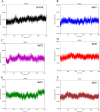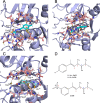Chalcogen Derivatives for the Treatment of African Trypanosomiasis: Biological Evaluation of Thio- and Seleno-Semicarbazones and Their Azole Derivatives
- PMID: 40547650
- PMCID: PMC12177781
- DOI: 10.1021/acsomega.5c02014
Chalcogen Derivatives for the Treatment of African Trypanosomiasis: Biological Evaluation of Thio- and Seleno-Semicarbazones and Their Azole Derivatives
Abstract
Human African trypanosomiasis (HAT) is caused by Trypanosoma brucei. Drug therapy remains challenging due to drug resistance and/or toxicity. New drugs are needed. Using thiosemicarbazones as a starting point, we employed a S to Se isosteric replacement strategy to design 44 analogs which were evaluated against T. brucei in vitro. Compounds were divided into 11 groups of four derivatives corresponding to thio-, selenosemicarbazones, and their cyclic counterparts, thio- and selenazoles. We selected three groups which contained a total of six derivatives that inhibited parasite growth by >70%. Then, we investigated the mechanism of action of these compounds, performing quantitative assays to measure their inhibition of the T. brucei cathepsin L-like protease (TbrCATL) and DPPH antioxidant activities. The lead compound (SeO3) showed antioxidant capacity and the best activity against T. brucei (EC50 = 0.47 μM). Nevertheless, its toxicity should be improved. We also predicted the interactions of these compounds with TbrCATL utilizing molecular dynamics. We demonstrate that the Se derivatives are more active than their S analogues, and that the selenazole ring decreases Se-associated toxicity. Also, thio- and selenosemicarbazones are more potent against TbrCATL than the cyclic derivatives. We conclude that TbrCATL inhibition should be combined with antioxidant activity to obtain active compounds against T. brucei.
© 2025 The Authors. Published by American Chemical Society.
Figures









Similar articles
-
Behavioral interventions to reduce risk for sexual transmission of HIV among men who have sex with men.Cochrane Database Syst Rev. 2008 Jul 16;(3):CD001230. doi: 10.1002/14651858.CD001230.pub2. Cochrane Database Syst Rev. 2008. PMID: 18646068
-
Systemic pharmacological treatments for chronic plaque psoriasis: a network meta-analysis.Cochrane Database Syst Rev. 2021 Apr 19;4(4):CD011535. doi: 10.1002/14651858.CD011535.pub4. Cochrane Database Syst Rev. 2021. Update in: Cochrane Database Syst Rev. 2022 May 23;5:CD011535. doi: 10.1002/14651858.CD011535.pub5. PMID: 33871055 Free PMC article. Updated.
-
Systemic pharmacological treatments for chronic plaque psoriasis: a network meta-analysis.Cochrane Database Syst Rev. 2017 Dec 22;12(12):CD011535. doi: 10.1002/14651858.CD011535.pub2. Cochrane Database Syst Rev. 2017. Update in: Cochrane Database Syst Rev. 2020 Jan 9;1:CD011535. doi: 10.1002/14651858.CD011535.pub3. PMID: 29271481 Free PMC article. Updated.
-
Synthesis and Biological Evaluation of New Chalcogen Semicarbazone (S, Se) and Their Azole Derivatives against Chagas Disease.J Med Chem. 2024 Nov 14;67(21):19038-19056. doi: 10.1021/acs.jmedchem.4c01535. Epub 2024 Nov 1. J Med Chem. 2024. PMID: 39485736 Free PMC article.
-
Immunogenicity and seroefficacy of pneumococcal conjugate vaccines: a systematic review and network meta-analysis.Health Technol Assess. 2024 Jul;28(34):1-109. doi: 10.3310/YWHA3079. Health Technol Assess. 2024. PMID: 39046101 Free PMC article.
References
-
- World Health Organization Trypanosomiasis, human African (sleeping sickness). https://www.who.int/news-room/fact-sheets/detail/trypanosomiasis-human-a... (accessed 2024, August 1).
-
- DNDI Sleeping sickness: Symptoms, transmission, and current treatments for sleeping sickness. https://dndi.org/diseases/sleeping-sickness/facts/. (accessed 2024, August 1).
-
- Coetzer, J. A. W. ; Thomson, G. R. ; Tustin, R. C. . Infectious diseases of livestock with special reference to Southern Africa; Oxford University Press: Cape Town, 1994.
-
- Pereira G. A., Santos L. H., Wang S. C., Martins L. C., Villela F. S., Liao W., Dessoy M. A., Dias L. C., Andricopulo A. D., Costa M. A.. et al. Benzimidazole inhibitors of the major cysteine protease of Trypanosoma brucei. Future Med. Chem. 2019;11:1537–1551. doi: 10.4155/fmc-2018-0523. - DOI - PMC - PubMed
LinkOut - more resources
Full Text Sources
